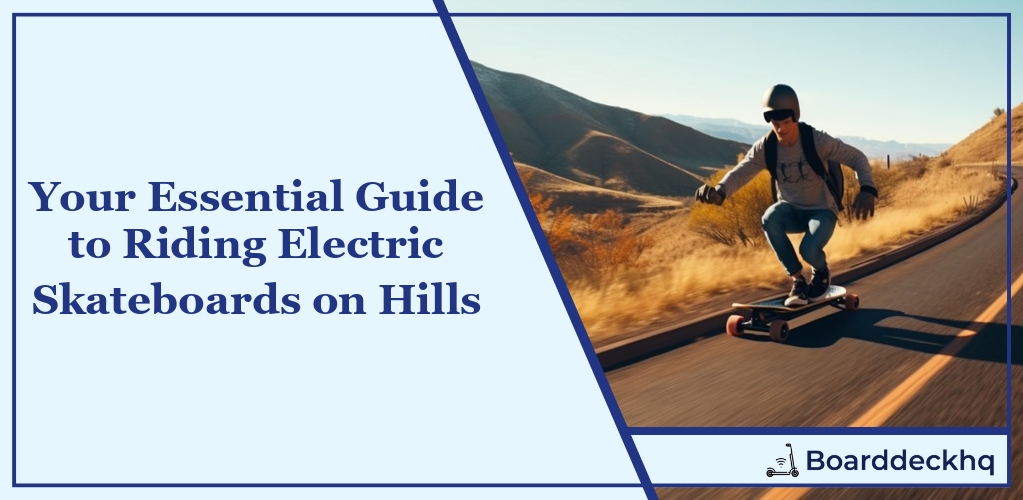Imagine a light breeze brushing against your face as you effortlessly ascend a steep hill on your electric skateboard; a machine that combines technology and adrenaline in the most liberating way. In this article, we are going to take you on a journey through the exhilarating world of hill riding on electric skateboards. We’ll delve into the dynamics that govern this thrilling activity and explore the critical factors that influence the hill-climbing prowess of these modern marvels.
What we’ll cover:
- Dynamics of Hill Riding
- Hill Climbing Factors
- Weight, Power, and Wheel Size Interplay
- Battery Life Challenges
- Impact of Uphill Riding
- Navigating Downhill
- Optimum E-Skateboarding for Hills
- Essential E-Skateboarding Accessories
- Off-Road Longboarding Tips
- Electric Skateboard Maintenance
The excitement of hill riding on an electric skateboard is unparalleled – but it’s not just about the thrill. It’s about understanding the dynamics, respecting the power, and maintaining your ride. So, let’s get rolling and discover what makes hill riding on electric skateboards such a captivating pursuit!
Understanding The Dynamics of Hill Riding
When it comes to mastering the art of hill riding on an electric skateboard, it’s crucial to understand how an electric skateboard works, as well as the complex relationship between the skateboard and hill gradients. An electric skateboard is a sophisticated piece of technology with its own mechanics that interact differently with varying gradient inclines.
The Role of Grade (Slope)
The concept of grade (or slope) is fundamental in longboarding. It refers to the steepness or incline of a hill, typically expressed as a percentage. The greater the grade, the steeper the hill, and the more challenging the ride becomes. Riding up a steep incline gradient on an electric skateboard requires more power and skill than cruising along a flat surface.
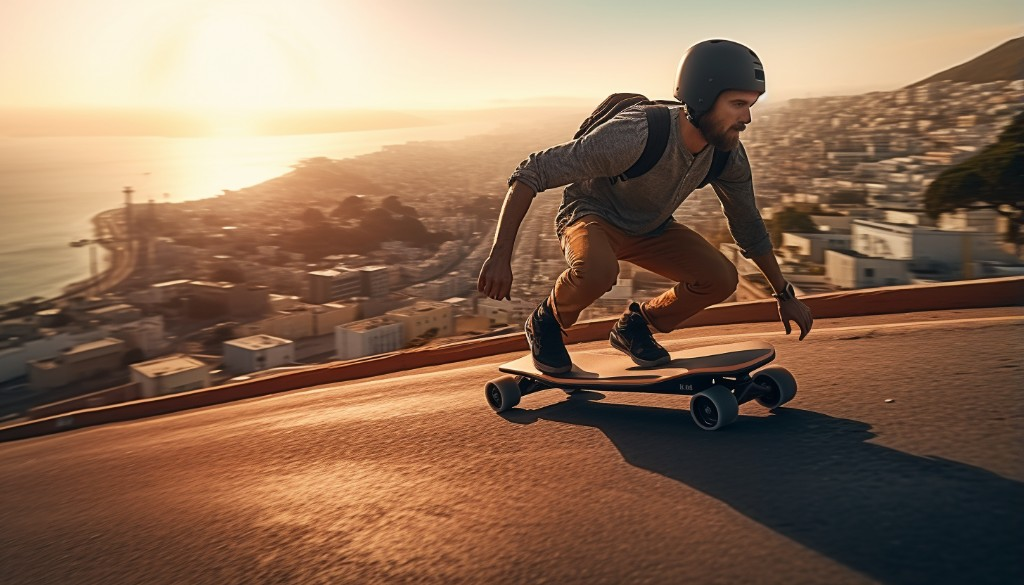
The Mechanics of Uphill Longboarding
The mechanics involved in uphill longboarding on an electric skateboard are quite intricate. To move up a hill, the skateboard must generate enough force to overcome gravity pulling it downwards. This is where the motor power and the torque of the electric skateboard come into play, which we will discuss in more detail in the next section.
Factors Influencing Hill Climbing Ability with Electric Skateboards
Many factors determine how well an electric skateboard can navigate uphill terrain. These include motor power, weight, and torque. Let’s delve deeper!
Role of Motor Power
The motor power is a crucial factor for climbing hills on an electric skateboard. Your skateboard needs a lot of power to overcome the forces of gravity acting against it on an incline. The stronger the motor, the easier it is for the skateboard to climb steep gradients.
Impact of Weight on Climbing Ability
Weight also plays a significant role in your climbing ability on an electric skateboard. Heavier riders may find it more challenging to climb steep hills compared to lighter ones, simply because there’s more weight for the skateboard’s motor to move uphill.
Importance of Torque in Uphill Rides
Torque is another critical factor when it comes to uphill rides on electric skateboards. It’s the rotational force that the motor produces, and it’s this force that propels you forward (or upward in this case). A motor with high torque will have an easier time climbing hills than one with low torque.

The Interaction between Weight, Power, and Wheel Size
The final piece of the hill riding puzzle lies in understanding how weight, power, and wheel size interact on an electric skateboard.
Rider’s Weight and Skateboard’s Power
As previously mentioned, a rider’s weight can significantly impact hill climbing ability. A heavy rider may require a board with a lot more power to climb steep hills efficiently. Conversely, a lighter rider might get away with less powerful motors.
Impact of Wheel Size
Wheel size is another factor that can affect your longboarding experience on hills. Larger wheels can handle rougher terrain and are generally more stable, making them suitable for downhill rides. However, they require more power from the motor to maintain speed, especially when going uphill.
In contrast, smaller wheels are quicker and lighter, offering faster acceleration and easier maneuverability. However, their performance may suffer on uneven or steep terrains due to their lower surface area contact.
By understanding these dynamics and factors, riders can better equip themselves for effective hill riding, ensuring a safer and fun-filled electric skating experience. Always remember that knowledge and preparation are key as they not only enhance your performance but also boost your confidence as you tackle those challenging slopes!
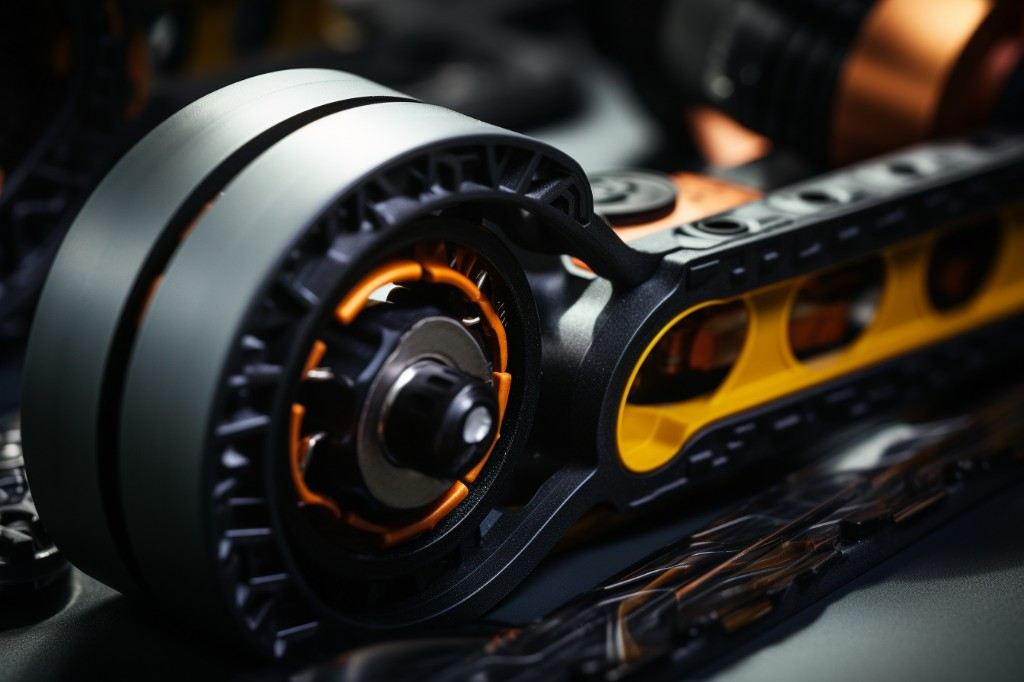
Battery Life: The Uphill Battle
When it comes to electric skateboards, the battery is the heart of the operation. It’s what powers the board and propels you forward. However, you may notice that when you’re tackling steeper inclines or hilly terrains, your electric battery depletes faster than usual. That’s because riding uphill can significantly drain the battery.
In layman’s terms, the motor of an electric skateboard requires more power to fight against gravity when ascending a hill. The steeper or longer the hill, the more power it requires, which directly translates to higher battery consumption.
Certainly, there are ways to help conserve battery life during uphill rides. One way is to modulate your speed. Rather than accelerating quickly, gradually increase your speed. This method uses less energy and can considerably reduce the drain on your battery.
Another method is to manually kick-push your electric skateboard at the start of the climb or on gentler slopes. This strategy reduces the workload of the electric motor, thereby conserving battery power. You’d be surprised how much longer your ride can last by integrating these simple habits into your uphill travels.
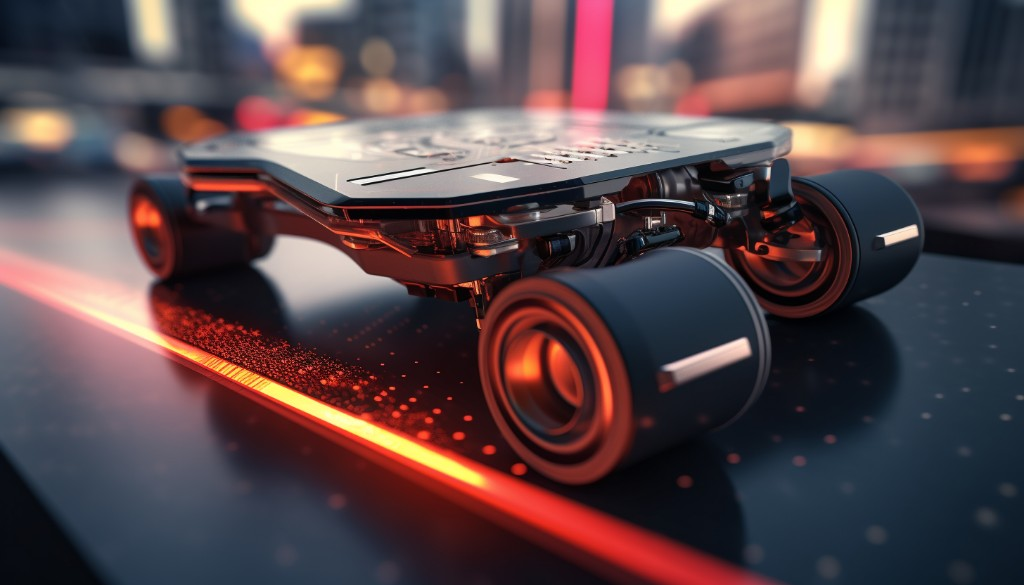
The Impact of Uphill Riding on Electric Skateboards
Just as we feel the burn in our muscles when climbing a flight of stairs, an electric skateboard also experiences differences when riding uphill. One significant change is in its range. An electric skateboard that could ordinarily travel a certain distance on flat ground will likely see its range decrease when faced with a hilly path.
The second major change is heat generation. More power used equates to more heat produced by the motor and battery. Consequently, when you ride an electric skateboard up a hill, it tends to get noticeably warm.
However, it’s crucial to prevent overheating as this can affect the performance and lifespan of your board. How do you do that? Well, one way is by taking breaks during your ride uphill. This allows the motor and battery some time to cool down.
Another measure is to keep your skateboard well-maintained. Regularly clean the vents and remove any debris that might block airflow and cause the board to overheat. Finally, avoid overloading your board as extra weight can cause it to work harder and heat up faster.

Navigating the Downhill Journey
If going uphill on an electric skateboard is all about power and endurance, then riding downhill is about control and technique. Skilled downhill riders are able to use this descent to their advantage by employing techniques such as carving or sliding, which can help maintain balance and control speed.
One insightful innovation in electric skateboarding technology is regenerative braking. In simple terms, this feature converts kinetic energy back into stored energy in the battery when you brake while riding downhill. So not only does it help control speed, but it also slightly replenishes your battery — pretty neat, right?
Maintaining balance during downhill riding is paramount. To help achieve this, ensure your weight is distributed properly over the board. Leaning too far forward or backward can lead to instability and potential accidents.
Additionally, applying some principles from downhill mountain biking like looking ahead on the path and bending your knees for better control can also be beneficial during downhill rides on an electric skateboard. Remember, practice makes perfect! The more you ride downhill, the better you’ll become at handling the challenges it presents.
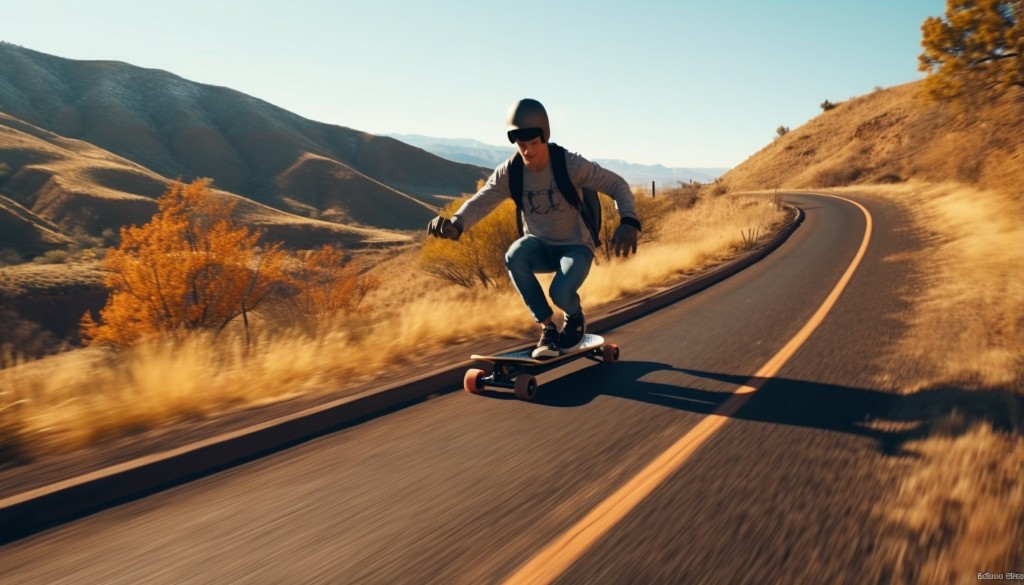
Choosing the Optimum Electric Skateboard for Hill Rides
When it comes to bombing hills on an electric skateboard, not all boards are created equal. Deciding on the best one to satisfy your need for speed and control can be a daunting task, especially given the myriad of options available on the market.
Regular vs. Premium Electric Skateboards
One of the first forks in the road you will encounter is the choice between a regular or premium electric skateboard. While both types can offer thrilling rides, there are key differences to consider.
A regular skateboard might serve you well if you’re a beginner or if you’re on a tight budget. But remember, it’s usually less powerful and might struggle with steep hills.
Premium electric skateboards, on the other hand, come with numerous high-end features. You’d get more powerful motors that make climbing hills a breeze, longer battery life, and advanced braking systems for better safety. The catch? They come with a higher price tag.

Factors to Ponder When Choosing an Electric Skateboard for Hills
When selecting an electric skateboard specifically for hill rides, certain factors demand your attention.
- Motor Power: Going uphill requires more power than cruising on flat terrain. Look for boards with dual motors as they provide more torque and better performance on steep inclines.
- Battery Capacity: You don’t want your board dying midway up a hill! Opt for a board with a higher battery capacity to ensure longer rides.
- Wheel Size and Material: Larger and softer wheels will give you better grip when tackling slopes, which enhances stability and control.
- Board Length and Weight: A longer and heavier board can offer a more stable ride uphill but can be harder to carry around.
- Hill Grade Ability: This is the maximum incline angle that the board can climb. A higher grade ability means the board can tackle steeper hills.
By paying attention to these factors, you should be able to find an electric skateboard that satisfies your hill-riding needs.

Essential Accessories for E-Skateboarding Adventures
Riding an electric skateboard is not just about picking the right board. Equipping yourself with essential accessories is pivotal to ensure safety and enhance your uphill riding experience.
Safety Gear: A Must-Have
As exhilarating as E-Skateboarding can be, it’s not without its risks, particularly when it comes to downhill rides. To protect yourself from potential accidents or injuries, investing in safety gear is non-negotiable.
The first line of defense is a good-quality helmet. No matter how experienced or confident you are as a rider, never underestimate the importance of protecting your head from potential impacts and life-changing injuries.
Next up is knee pads and elbow pads. Designed to protect your joints from impact during a fall, they are essential in preventing scrapes and bruises to your joints.
Wrist guards are another piece of safety gear that you should consider. They protect your hands and wrists if you put them out to break a fall, which most riders do on instinct.
Padded shorts, jackets and back protectors are other items you may want to consider investing in when undertaking uphill skateboarding.
Remember, dressing appropriately can make all the difference between walking away from a fall unscathed and suffering serious injury.
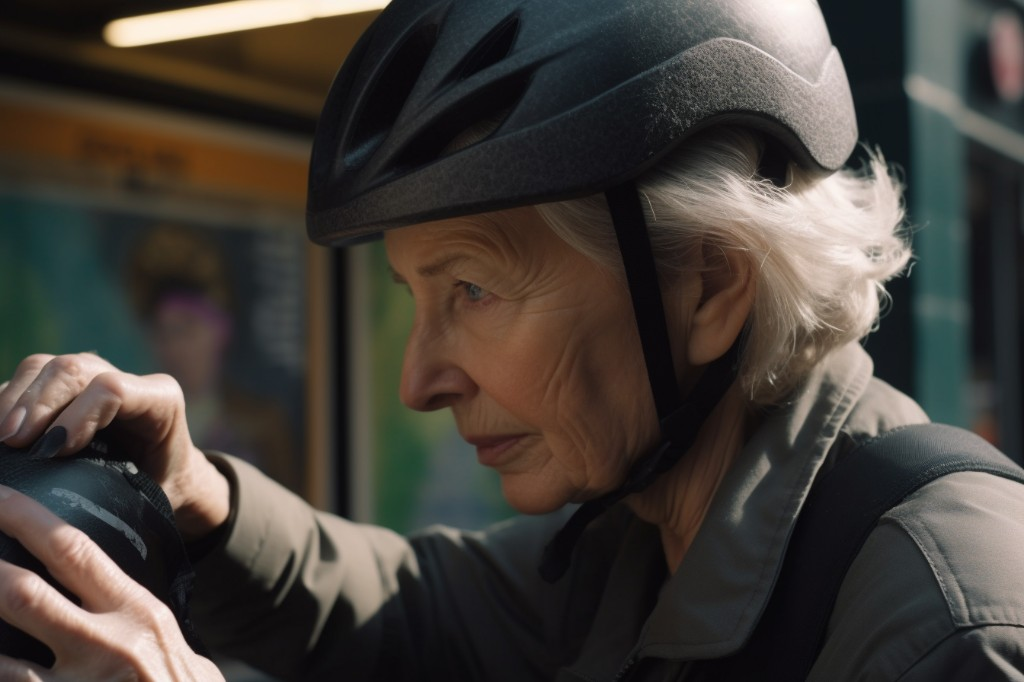
The Crucial Role of A Remote Control
The remote control is an integral part of your electric skateboard setup. It gives you complete control over your ride by allowing you to adjust your speed, brake efficiently, and even reverse when needed.
A well-designed remote control should feel comfortable in your hand and be easy to use, even at high speeds. Some premium models also display useful information like your speed, battery life, and distance covered.
Whether you’re bombing hills or cruising through city streets, having these essential accessories can drastically enhance your E-Skateboarding adventure’s safety and enjoyment.
Embracing Off-Road Longboarding: Tips and Techniques
Off-road longboarding is an exhilarating experience that requires its own set of tricks and techniques. Unlike traditional skateboarding on smooth urban surfaces, off-road skateboarding demands a different approach to handle the rugged conditions found on trails and uneven terrains, both uphill and downhill.
One of the most crucial things to master in off-road longboarding is your stance. The way you position your body on the board can greatly influence your control and stability. A lower stance, with knees bent and most of the weight over your front foot, can provide better balance while cruising off-road.
Also, the way you place your feet on the board, or foot placement, is equally important. Your front foot should align diagonally with the board’s trucks, while the back foot should rest near the tail. This arrangement allows for quick pivoting, which is essential when navigating through rocky trails.
Remember, practicing these techniques regularly can help you enhance your off-road longboarding skills. So, get out there on the trail, experiment with your stance and foot placement, and experience the thrill of off-road electric skateboarding!

Maintaining Your Electric Skateboard
An electric skateboard is a significant investment, and as with any investment, it’s essential to take good care of it. Regular maintenance can not only prolong the life of your skateboard but also ensure it performs at its best. Here are some handy tips for electric skateboard maintenance.
Dirt and debris can cause considerable wear and tear to your skateboard, especially if you frequently ride on hills. After each ride, make a habit of cleaning the deck, trucks, and wheels with a soft, damp cloth. Avoid using harsh chemicals that might damage your skateboard. Also be sure to check for any loose screws or bolts and tighten them if necessary.
Regarding the wheels, check them regularly for any signs of cracks or chips. If they look worn out, it may be time to replace them. Also, remember to lubricate the wheel bearings periodically to ensure smooth and safe rides.
Your skateboard’s battery health is another critical aspect of upkeep. Never overcharge the battery as it could reduce its lifespan. Instead, charge it up to around 80% for optimal performance and longevity. Be sure to check for swelling and leaks, especially if you’ve recently used your skateboard for extreme uphill adventures.
Furthermore, always store your electric skateboard in a cool, dry place to prevent any damage from humidity. If you’re not planning to use it for a while, make sure the battery level is at least 60% before storage to avoid any potential issues.
By following these tips for electric skateboard maintenance, you can ensure that your ride stays in top shape, delivering thrilling uphill rides for years to come.

Closing Thoughts
Mastering the dynamics of hill riding with an electric skateboard involves a nuanced understanding of various factors that influence its climbing ability. This includes a consideration of the interplay of weight, power, and wheel size — each playing a significant role in overcoming inclines. Another crucial aspect to note is the battery life, which is often under siege during uphill rides. The impact of uphill riding on electric skateboards is substantial and thus, having a clear understanding of this relationship is essential in making the most out of your skateboarding sessions.
On the flip side, navigating the downhill journey can be a thrilling yet challenging endeavor and knowing how to do this safely is paramount. When choosing the optimum electric skateboard for hill rides, being informed about these elements can help significantly in making the right choice. Additionally, equipping yourself with essential safety gear accessories can enhance your electric skateboarding adventures. For those who wish to take their skills off the beaten track, embracing off-road longboarding could open up a whole new world of tips and techniques to explore. Lastly, remember that maintaining your electric skateboard is vital in ensuring its longevity and performance.
Whether you’re a newcomer to the sport or an old-timer, follow the tips in this guide to make the most of your uphill electric skateboarding adventures and experience the thrill of a lifetime!
Frequently Asked Questions
How steep can an electric skateboard climb?
The steepness an electric skateboard can climb largely depends on its motor power, the rider’s weight, and the wheel size. More powerful motors, lighter riders, and larger wheels typically allow for steeper climbs.
What factors affect my ability to climb hills with an electric skateboard?
Several factors can influence your ability to climb hills with an electric skateboard. These include the power of the skateboard’s motor, your weight as a rider, the size of the skateboard’s wheels, and the steepness of the hill you’re attempting to climb.
How does uphill riding impact my electric skateboard’s battery life?
Uphill riding puts a significant strain on your electric skateboard’s battery, causing it to drain faster than usual. This is due to the increased power demand required to overcome the force of gravity when climbing.
What is regenerative braking and how does it help in downhill riding?
Regenerative braking is a feature in some electric skateboards that allows them to convert some of the energy used in braking back into battery power. This can be particularly useful in downhill riding, where constant braking can actually help recharge the skateboard’s battery.
Can I use a regular skateboard instead of a premium electric skateboard for hill rides?
While it’s possible to use a regular skateboard for hill rides, it will likely be more challenging than using an electric one. Electric skateboards are designed with powerful motors that assist in uphill climbing and regenerative braking systems for safe and controlled downhill rides. Regular skateboards lack these features, making hill rides more physically demanding and potentially less safe.
